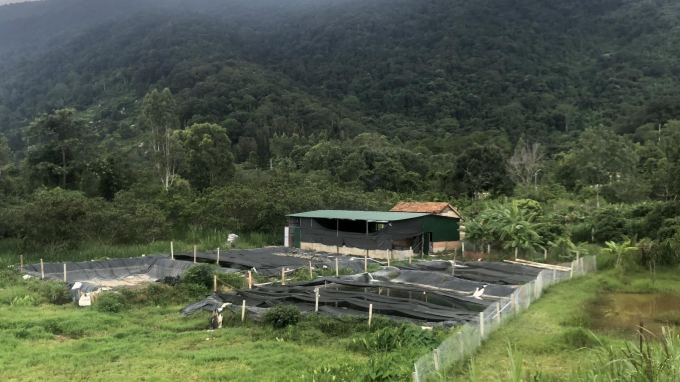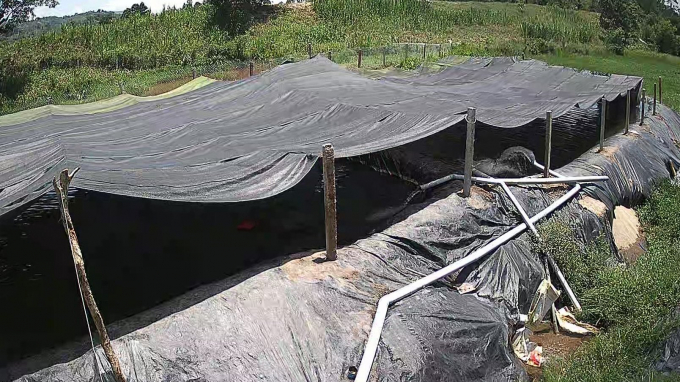November 27, 2025 | 19:49 GMT +7
November 27, 2025 | 19:49 GMT +7
Hotline: 0913.378.918
November 27, 2025 | 19:49 GMT +7
Hotline: 0913.378.918

A sturgeon breeding farm in Dak Lak Province. Photo: Minh Quy.
According to Dak Lak Fisheries Sub-Department, the province has a lot of potential for cold-water fish development along the streams in the Chu Yang Sin mountain range.
A survey conducted by local authorities has discovered potentials for raising salmon in Cu Dram Commune (Krong Bong District) while those for raising sturgeon are found in Yang Mao, Cu Dram, Cu Pui, Hoa Son communes, and Krong Kmar town (Krong Bong District), and Dak Phoi and Krong No in Lak District.
In addition to streams, Dak Lak also has the advantage in exploiting a large water surface area thanks to hydroelectric and irrigation reservoirs that are eligible for raising cold-water fish such as Buon Tua Srah hydropower reservoir (Lak District); Ho Ke lake, Krong Kmar hydropower reservoir (Krong Bong District); Krong Pac Thuong lake (Ea Kar District); Buon Joong lake (Cu M'Gar District); Krong Buk Ha lake (Krong Pac District)…
Mr. Trinh Ba Son, Deputy Director of the Dak Lak Fisheries Sub-Department, said that sturgeon farming started 10 years ago in the area. Up to now, some localities with the weather of low temperatures such as Krong Bong and Lak Districts are favorable for the development of cold-water fish. Sturgeon farming units said local conditions were quite suitable for growing this fish. The price of sturgeon compared to other aquatic products is much higher, so it brings a great source of income.
Currently, Dak Lak Province has 3 large sturgeon farming units with an annual output reaching hundreds of tons. Among them, the Vietnam-Dak Lak Sturgeon one-member limited company owns 484 cages with a total water surface area of nearly 4ha while the Truong Toan sturgeon farm has 48 cement tanks and the farmer household of Tran Huu Bac is raising sturgeon in 6 ponds.
“In the past, sturgeon and salmon were mainly raised in Lam Dong Province, but recently, this locality ran out of land, so investors moved to Dak Lak. The area along the Chu Yang Sin mountain range has many more trees and clean water compared to Lam Dong, so it has attracted much attention from investors. Realizing these potentials, the Fisheries Sub-Department advised the provincial People's Committee to issue a plan to develop the sturgeon farming for 2021-2025 period," Mr. Son said.

The Dak Lak Fisheries Sub-Department advises the provincial People's Committee to issue a plan to develop sturgeon farming for the period 2021 - 2025. Photo: Minh Quy.
According to the plan, by 2025, Dak Lak targets to achieve about 2,000 tons of cold water fish productivity. The output of sturgeon and salmon is expected to reach about 1,900 tons and 100 tons respectively while the caviar output is about 5 tons. Products processed from sturgeon expect to reach about 500 tons.
Dak Lak is striving for 100% of sturgeon farming establishments to be granted certificates in food safety and 70% of the area is qualified for VietGAP certificate in aquaculture. 100% of raising cages are granted certificate codes according to regulations and can produce 20-30% of the quality breeds meeting demands for commercial farming.
“The local production capacity is large but the consumption market is still small so the output has not reached its potential. Many investors have worked with local authorities to implement sturgeon farming models. The localities hope that in the near future Dak Lak sturgeon will be one of the leading units in the country," according to Mr. Son.
Son also said that the Sub-Department of Fisheries has asked the districts to create favorable conditions for organizations and individuals to come to survey and apply for a policy on raising sturgeon. Besides, the Dak Lak Fisheries Sub-Department also advised the provincial People's Committee to support individuals and businesses while investing in the locality.
"For the development of cold-water fish industry, the sub-department has also advised the provincial People's Committee to build a chain from breed production to consumption. How to make it come true that in the future Dak Lak will be one of the leading provinces in sturgeon farming in the country," said the deputy director of Dak Lak Fisheries Sub-Department.
Translated by Linh Nguyen

(VAN) According to Mr. Vo Minh Thanh, Director of the Tay Ninh Department of Agriculture and Environment, Resolution 57 has created a new development pathway for the locality, shifting from traditional toward modern agriculture.
/2025/11/26/4909-2-154329_878.jpg)
(VAN) Pearl grouper farming in HDPE cages not only delivers economic efficiency but also contributes to protecting the environment, creating jobs, and promoting marine-based experiential tourism.

(VAN) The model of making a living under the forest canopy through the agroforestry system in Van Son commune, Bac Ninh province, is expected to generate an annual income of approximately VND 30 million/ha.

(VAN) Many enterprises in Can Tho are harnessing natural energy and reducing greenhouse gas emissions in their production processes, thereby contributing to the promotion of a sustainable green transition.
/2025/11/24/3536-2-112800_176.jpg)
(VAN) Dong Nai now has tens of thousands of hectares of forests certified for sustainable management, and this area will continue to be expanded in the coming period.

(VAN) Vinh Ha hamlet (Dai Xuyen commune, Hanoi) is shifting away from small-scale farming as households adopt bioscurity into their breeder chicken models.

(VAN) Heavy rains make aquatic species more vulnerable to disease. Proactive water management and high-tech systems help farmers prevent outbreaks and protect yields.